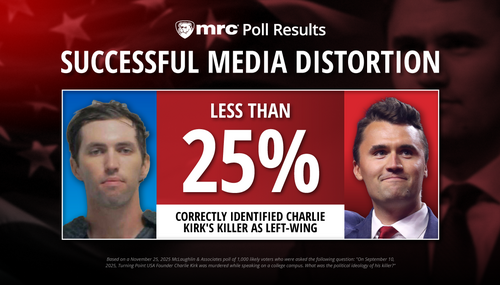 In the cover story for Time magazine’s Person of the Year issue, writer Karl Vick explained the publication’s decision to name journalists as persons of the year. Amid highlighting the plight of murdered or imprisoned reporters in dictatorships around the world, Vick interwove repeated jabs at President Trump, blaming the American leader for launching a “war on truth” that has endangered the free press.
In the cover story for Time magazine’s Person of the Year issue, writer Karl Vick explained the publication’s decision to name journalists as persons of the year. Amid highlighting the plight of murdered or imprisoned reporters in dictatorships around the world, Vick interwove repeated jabs at President Trump, blaming the American leader for launching a “war on truth” that has endangered the free press.
“[The] world is led, in some ways, by a U.S. President whose embrace of despots and attacks on the press has set a troubling tone,” Vick proclaimed early in the lengthy article. One of the media figures featured on one of the multiple covers, Filipino journalist Maria Ressa, lamented: “I think the biggest problem that we face right now is that the beacon of democracy, the one that stood up for both human rights and press freedom—the United States—now is very confused. What are the values of the United States?”
Vick argued: “In normal times, the U.S. news media is so much a part of public life that, like air, it’s almost impossible to make it out.” In other words, the press are supposedly such objective bystanders that they go unnoticed as they simply chronicle current events. He then bemoaned reporters suddenly being thrust into the spotlight by Trump: “But it has been made conspicuous—by the attacks and routine falsehoods of the President, by social-media behemoths that distribute news but do not produce it and by the emerging reality of what’s at stake.”
The absurd notion that members of the news media were, up until now, quietly toiling away not seeking recognition or attention doesn’t pass the laugh test.
“Efforts to undermine factual truth, and those who honestly seek it out, call into doubt the functioning of democracy,” Vick warned. Later in the piece, he wrung his hands over faith in the national news media declining, singling out one particular cable channel for blame:
In 1996, Fox News Channel was founded on the assumption that the national media reflected the liberal inclinations of journalists working for it. And surveys did show a lean to the left in their personal politics. Fox was not the first news outlet to thrive by offering news viewers the satisfaction of a shared view of the world—MSNBC, its liberal counterpart, premiered four months earlier—but it was the most strikingly partisan in a television landscape that historically tried not to be.
The most sanctimonious declaration from the story came when Vick lectured:
For a certain kind of politician, there is an almost liberating genius to framing independent journalists as the enemy. Stray from the truth, and whoever corrects you can be dismissed as “the other side.” The strategy runs on a dangerous assumption—that we’re not all in this together.
“All in this together”? Is that the concept the media thought it was promoting all these years? After spending decades smearing conservatives as racist, uncaring, or even sinister? No, the liberal press has routinely made it clear that it views people on the political right as the enemy.
Calling out Trump for using the word “enemy of the people” to describe journalists, Vick eagerly drew comparison to an authoritarian regime that killed millions:
The President may not have known the history of the phrase. It was used in the Soviet Union, to condemn subordinates at the 1930s show trials Joseph Stalin ordered before executing those who had fallen out of favor. “The people” were peasants who had starved after Stalin confiscated grain harvests. The officials were the dictator’s scapegoats.
Trying to bolster the flimsy case that the American media were steadfastly resisting the urge to become political activists, Vick stated: “For now, the most prominent U.S. newspapers resist a combat role.” A quote was featured of Washington Post editor Martin Baron assuring, “We’re not at war with the Administration. We’re at work.”
Vick immediately belied that assurance by detailing the dramatically hostile “work” being done by major newspapers:
And there’s been a lot of work to do. In the first year of the Trump presidency, 25 top Administration officials and Cabinet members have resigned or been fired—more than triple the percentage of Obama, Clinton and both Bushes, and double that of Reagan—following revelations of conflicts of interest, corruption or other impropriety, many uncovered by reporters. The New York Times dug through 100,000 pages of documents to determine that Trump had received at least $413 million from his father, and participated in “dubious tax schemes during the 1990s, including instances of outright fraud.” The Wall Street Journal revealed candidate Trump had paid $130,000 to porn star Stormy Daniels, an apparent campaign-finance felony. ProPublica’s release of a recording of children crying in a detention center galvanized public attention on the Administration’s “zero tolerance” policy of separating children from their parents at the border with Mexico.
“It’s accountability reporting of the first order, backed by long tradition and legal protections,” the reporter hailed.
After noting the White House temporarily revoking the press credentials of CNN reporter and provocateur Jim Acosta, Vick hyped:
For the first time in living memory, an element of personal danger has entered coverage of public affairs in America. Bodyguards now escort CNN reporters through Trump rallies, and the network’s Manhattan newsroom was evacuated in October when its mail room found one of the 16 pipe bombs addressed to Trump critics. Police traced the bombs to a Florida man living in a van plastered with Trump stickers.
It’s one thing to recognize the sacrifices of journalists who have been persecuted or even killed trying to report the truth about dictatorial regimes. It’s quite another to in any way equate those desperate circumstances with anything happening in the United States.




